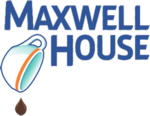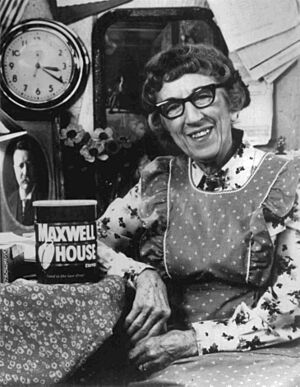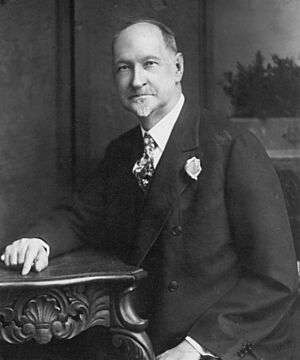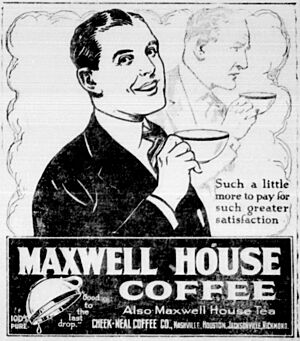Maxwell House facts for kids
 |
|
| Owner | Kraft Heinz (North America) JDE Peet's (Rest of the world) |
|---|---|
| Introduced | 1892 by Joel Owsley Cheek |
| Related brands | Gevalia |
| Previous owners |
|
| Tagline | Good to the last drop |
Maxwell House is a famous American brand of coffee. It is made by Kraft Heinz in North America and by JDE Peet's in other parts of the world. The brand started in 1892 thanks to a grocer named Joel Owsley Cheek. It got its name from the Maxwell House Hotel in Nashville, Tennessee, which was its first big customer.
For almost 100 years, until the late 1980s, Maxwell House was the most popular coffee brand in the United States. Its well-known slogan is "Good to the last drop." You can often see this phrase on its logo and coffee labels. Over the years, different companies have owned Maxwell House, including Cheek's own Nashville Coffee and Manufacturing Company, then General Foods, and later Kraft Foods Inc..
Contents
The Story of Maxwell House Coffee
How It All Began
In 1884, a man named Joel Owsley Cheek moved to Nashville. There, he met Roger Nolley Smith, a coffee expert from Britain. Roger was so good at his job that he could tell where coffee beans came from just by smelling them!
For several years, Joel and Roger worked together to create the perfect coffee blend. In 1892, Joel offered 20 pounds of his special coffee blend for free to the food buyer at the Maxwell House Hotel. After a few days, the hotel ran out of Joel's coffee and went back to its usual brand. But customers and others who had tried Joel's coffee complained! They liked his blend much better.
Because of this, the hotel decided to buy Joel's coffee exclusively. After six months of success, the hotel allowed Joel to name his coffee after their famous hotel.
From Idea to Company
Inspired by his success, Joel Cheek left his job as a coffee broker. He teamed up with Maxwell Colbourne to start a company called the "Nashville Coffee and Manufacturing Company." They focused on coffee, and Maxwell House Coffee became their main product.
Later, their company changed its name to the "Cheek-Neal Coffee Company." Over the next few years, Maxwell House Coffee became a very respected name. It stood out from other coffee brands because of its quality.
The Famous Slogan: "Good to the Last Drop"
In 1915, the Cheek-Neal company started using the slogan "Good to the last drop" to advertise Maxwell House Coffee. For a while, the ads didn't say who first said the phrase.
Then, in 1925, General Foods bought the Maxwell House brand. By the 1930s, their ads claimed that former President Theodore Roosevelt had said the phrase. The story went that he visited The Hermitage, near Nashville, in 1907. After sipping Maxwell House coffee, he supposedly declared it "good to the last drop."
However, Maxwell House later admitted that the slogan was actually created by Clifford Spiller, who was a president of General Foods. The phrase "Good to the last drop" is still a registered trademark for Maxwell House and is part of its logo today.
Growing the Product Line
Instant Coffee and New Blends
During World War II in 1942, General Foods Corporation began supplying instant coffee to the U.S. armed forces. After the war, in 1945, this instant coffee, now called Maxwell House Instant Coffee, was sold in stores. It became available across the country the next year.
The company also introduced special coffees for different brewing methods. In 1966, "Maxwell House ElectraPerk" was made for electric percolators. In 1976, "Maxwell House A.D.C." coffee was created for automatic drip coffeemakers, which were becoming very popular.
Over the years, Maxwell House added many new types of coffee. In 1981, they launched Maxwell House Master Blend. In 1989, they introduced Rich French Roast, Colombian Supreme (made with 100% Colombian coffee), and 1892, a slow-roasted blend. In the early 1990s, they even added cappuccino products like Cappio Iced Cappuccino and Maxwell House Cappuccino.
Ownership Changes
In 2012, Kraft Foods Inc. split into two companies. Because of this, the rights to the Maxwell House brand were divided. Today, Kraft Heinz owns Maxwell House in North America. JDE Peet's (which was formed from a merger of Douwe Egberts and part of Mondelez International) owns the brand in the rest of the world.
Decaffeinated Options
General Foods had other decaffeinated coffee brands like Sanka since the 1920s. But they didn't sell Maxwell House-labeled decaffeinated coffee until 1983. That year, they introduced ground Maxwell House Decaffeinated coffee on the East Coast.
In 1985, Maxwell House Instant Decaffeinated Coffee became available. Later, in 1992, they launched Maxwell House Lite, which is a blend with less caffeine.
Advertising Maxwell House
Radio and TV Ads
Maxwell House became very well-known through its advertising campaigns. In the 1930s and 1940s, Maxwell House sponsored popular radio shows like Maxwell House Coffee Time and The Goldbergs.
They also sponsored the radio version of Father Knows Best. Each episode started with a child asking, "Mother, is Maxwell House really the best coffee in the whole world?" The mother would reply, "Well, your father says so, and Father Knows Best!"
On television, Maxwell House was a long-time sponsor of the early TV series Mama from 1949 to 1957. The family in the show often gathered for a cup of Maxwell House coffee. This was one of the first times a product was shown directly in a TV show.
In the 1970s, actress Margaret Hamilton, famous as the Wicked Witch of the West in The Wizard of Oz, appeared in Maxwell House ads. She played Cora, a general store owner who proudly sold only Maxwell House coffee.
Print Ads and the Haggadah

Maxwell House also used many print advertisements, always featuring the "good to the last drop" slogan. A very special part of their advertising began in 1932. The Joseph Jacobs Advertising Agency started publishing the Passover Haggadah for Maxwell House. This made Maxwell House a household name for many American Jewish families.
This was a clever marketing idea. An Orthodox rabbi even certified that coffee beans were not "kitniyot" (a type of food not eaten during Passover), making coffee kosher for Passover. Maxwell House was the first coffee company to specifically market to Jewish families. The Maxwell House Haggadah was even used for the annual White House Passover Seder when President Barack Obama was in office.
Where Maxwell House Coffee Is Made

Maxwell House has had several large factories over the years. Today, its main factory for the North American market is in Jacksonville, Florida.
The company first made its coffee in Hoboken, New Jersey. This factory closed in the early 1990s. Its huge sign, showing the brand name and a dripping coffee cup, was a famous landmark visible from New York City. The Hoboken site is also believed to be where the first organized baseball game was played.
Other factories were located in Houston, Texas, and San Leandro, California. The Houston plant was sold in 2006 and closed in 2018. The San Leandro plant closed in 2016.
See also
- Maxwell House Haggadah





